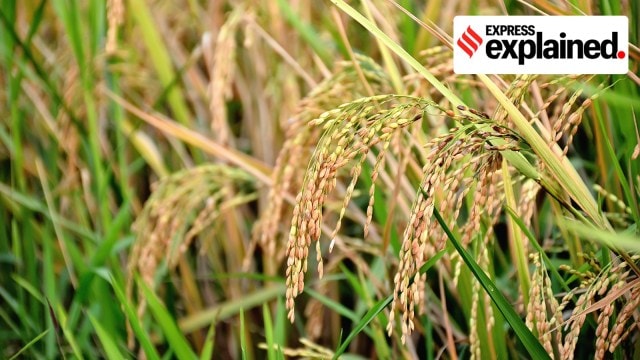Why Punjab CM has announced advancing the paddy transplantation season this year
What prompted the move in one of India's biggest rice-producing states? How have farmers responded to the decision? We explain.
 In the 2024-25 paddy procurement season in Punjab, farmers faced challenges due to high moisture content in their crops, leading to delays in procurement and reduced payments. (Wikimedia Commons)
In the 2024-25 paddy procurement season in Punjab, farmers faced challenges due to high moisture content in their crops, leading to delays in procurement and reduced payments. (Wikimedia Commons)Punjab Chief Minister Bhagwant Mann announced on Saturday (March 29) that the paddy transplantation season will commence on June 1 this year. This marks a shift, with transplantation beginning from June 11 onwards last year and never initiating as early as June 1 since 2009.
During the Punjab State Assembly’s Budget session, which concluded on March 28, opposition MLAs (particularly from the Congress party) raised concerns regarding paddy procurement.
In the 2024-25 kharif season, Punjab’s total area under paddy cultivation was approximately 32 lakh hectares, including 25.6 lakh hectares for non-basmati paddy and 6.4 lakh hectares for basmati varieties. What prompted the move in one of India’s biggest rice-producing states? How have farmers responded to the decision? We explain.
What has Mann announced?
On March 29, Mann said, “In order to avoid complications to the farmers in selling their paddy harvest due to high moisture content in October, the state government has decided to advance the paddy cultivation season from June 1.”
The idea is that the harvesting schedule will be advanced by about 10 days in October, when the average temperature is on the higher side, thus reducing the crop’s moisture content.
In 2024, paddy transplantation had started in six districts (Muktsar, Faridkot, Fazilka, Ferozepur, Bathinda and Mansa) of the Malwa region on June 11 and on June 20 in the remaining 17 districts. In past years, paddy transplantation has generally started after June 10.
It was in 2009 that the then Punjab government (led by SAD-BJP) brought in The Punjab Preservation of Subsoil Water Act, aiming to conserve groundwater by mandatorily delaying paddy cultivation and prohibiting transplantation before June 10. Before 2009, farmers used to undertake transplantation in May as well.
Mann further stated that zone-wise cultivation of the paddy crop will be done in the state. The government also aims to reduce paddy cultivation by promoting maize (corn) cultivation for ethanol production as part of its strategy to promote crop diversification and reduce the environmental impact of paddy cultivation.
What prompted the shift?
In the 2024-25 paddy procurement season in Punjab, farmers faced challenges due to high moisture content in their crops, leading to delays in procurement and reduced payments.
While ideal moisture levels at harvest are around 21-22% for paddy, they fall to the prescribed limit of 17% by the time the crop reaches mandis. Heavy rainfall in September increased moisture levels last year, delaying procurement. This led to overcrowded mandis and storage issues. Farmers who waited for moisture levels to drop suffered weight loss in their produce, reducing their earnings.
For every 1% drop in moisture, approximately 800 grams per quintal was lost, said Harmeet Singh Kadian, president of Bharti Kisan Union (Kadian). Paddy with moisture content above 17% was rejected or bought at lower prices by private traders. Farmers organised protests over unsold paddy, delayed payments, and procurement inefficiencies.
How have farmers responded?
Farmers had demanded better procurement systems and fair compensation to tackle these recurring challenges. In a March 3 meeting of Sanyukt Kisan Morcha held with the Punjab CM, farm leaders stated that either moisture content of up to 21% should be accepted or paddy transplantation dates should be advanced. Though Mann had abruptly walked out of that meeting, he has now accepted the demand and we welcome his announcement, said Kadian.
He added, “The window between paddy harvesting and wheat sowing will be at least 15 days, and it will be good for the farmers and the government. Moisture content is likely to be within the prescribed limits, and even stubble mulching (of the paddy crop) can happen in the fields in time.” Farmers expect the procurement season will likely end 15 days earlier if the transplantation season starts on June 1.
Though an official notification regarding the zones is yet to be released, sources revealed that blocks such as Muktsar, Mansa, Bathinda, Faridkot, Ferozepur, and Fazilka will be allowed to start transplantation from June 1 as they face issues of sub-surface waterlogging.
Though farmers have largely welcomed the announcement, they stated that the Punjab government didn’t guide farmers about what varieties should be cultivated. Last year, the quick-growing PR 126 was planted and harvested early by many farmers, resulting in a glut in the market. Its high processing cost became another concern for millers. Another challenge is that the Punjab government has yet to hold any meetings with the rice millers, while many farmers have already purchased different seed varieties from various Kisan melas.
- 01
- 02
- 03
- 04
- 05






































